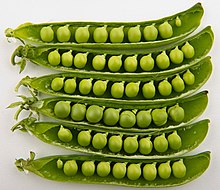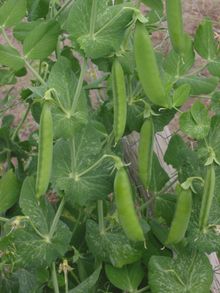**Botanical Information and History**:
– Peas, scientifically known as Pisum sativum, are annual plants with a one-year life cycle.
– Wild peas originated in the Mediterranean Basin and Near East, with archaeological finds dating back to the late Neolithic era.
– Garden peas were considered a luxury in Early Modern Europe.
– Constant selection since the Neolithic era has improved pea yield.
– Pea pods are botanically considered fruit, with an average weight ranging from 0.1 to 0.36 grams.
**Culinary Uses and Nutrition**:
– Peas are consumed fresh, frozen, or canned, and are used in dishes like pease porridge and pea soup.
– Green peas are rich in vitamin C, vitamin K, thiamine, and manganese, with moderate amounts of B vitamins and dietary minerals.
– Nutritionally, raw green peas contain 14.45g of carbohydrates, are low in fat (0.4g per 100g), and are a good source of dietary fiber (5.1g per 100g).
– Peas also contain vitamins A, B, C, E, and K, as well as minerals like calcium, iron, magnesium, manganese, and zinc.
– Split peas are a good source of pantothenic acid and folate.
**Cultivation and Genetics**:
– Peas are planted from winter to early summer and do well in cooler, high-altitude, tropical areas.
– Pea plants can self-pollinate, and various support methods like pea sticks and metal fences are used for cultivation.
– Mendel’s experiments with peas revolutionized genetics, showcasing dominant and recessive trait inheritance.
– The International Pea Genome Sequencing Consortium developed the first pea reference genome, with the genome size being 4.45Gb and consisting of seven chromosomes.
– Different pea cultivars like Kelvedon Wonder and Recruit Peas are popular, with resources available for growing and genetic improvement.
**Production and Processing**:
– Peas are frozen through processes like air blast freezing after being grown, picked, and shelled.
– Tender peas are selected for freezing to prevent spoilage, and blanching is done to remove enzymes before freezing.
– Nitrogen fixation in peas aids in plant growth, and pea diseases caused by various pathogens are studied for effective management.
– Pea leaf weevil and pea moth are common pests affecting pea plants and can impact crop yields.
– Pea grading involves sorting by size for tenderness, and peas must be frozen shortly after picking.
**Health Benefits, Allergens, and Genetic Disorders**:
– Peas are rich in protein and fiber, with pea milk being a popular dairy alternative.
– Pea sprouts are a nutritious vegetable, and wasabi peas are considered a healthy snack.
– Peas can trigger allergic reactions in some individuals, with vicilin and convicilin being major allergens.
– Favism, a genetic disorder related to pea consumption, can cause severe reactions.
– Peas are beneficial for glucose-6-phosphate dehydrogenase deficiency, and they play a role in biological sciences research, particularly in nitrogen mobilization in seedlings.
This article needs additional citations for verification. (March 2017) |
Pea (Pisum in Latin) is a pulse, vegetable or fodder crop, but the word often refers to the seed or sometimes the pod of this flowering plant species, formerly 'Pisum sativum' (meaning cultivated pea), it has been proposed to rename the species as Lathyrus oleraceus. Each pod contains several seeds (peas), which can have green or yellow cotyledons when mature. Botanically, pea pods are fruit, since they contain seeds and develop from the ovary of a (pea) flower. The name is also used to describe other edible seeds from the Fabaceae such as the pigeon pea (Cajanus cajan), the cowpea (Vigna unguiculata), the seeds from several species of Lathyrus and is used as a compound form for example Sturt's desert pea.
| Pea | |
|---|---|

| |
| Peas are contained within a pod. | |

| |
| Pea plant: Lathyrus oleraceus | |
| Scientific classification | |
| Kingdom: | Plantae |
| Clade: | Tracheophytes |
| Clade: | Angiosperms |
| Clade: | Eudicots |
| Clade: | Rosids |
| Order: | Fabales |
| Family: | Fabaceae |
| Subfamily: | Faboideae |
| Genus: | Lathyrus |
| Species: | L. oleraceus
|
| Binomial name | |
| Lathyrus oleraceus Lam. (1779)
| |
| Synonyms | |
|
Synonymy
| |
Peas are annual plants, with a life cycle of one year. They are a cool-season crop grown in many parts of the world; planting can take place from winter to early summer depending on location. The average pea weighs between 0.1 and 0.36 gram. The immature peas (and in snow peas the tender pod as well) are used as a vegetable, fresh, frozen or canned; varieties of the species typically called field peas are grown to produce dry peas like the split pea shelled from a matured pod. These are the basis of pease porridge and pea soup, staples of medieval cuisine; in Europe, consuming fresh immature green peas was an innovation of early modern cuisine.
